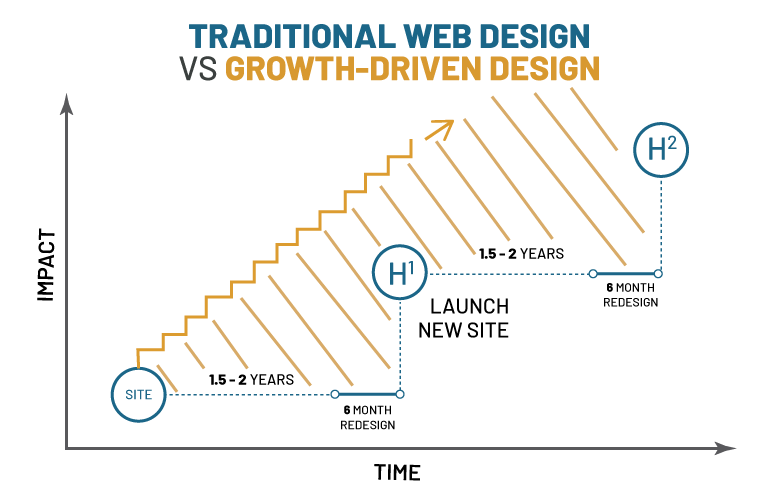Everybody wants to rule the world, but only a select few will rule Google.
Ranking on the first page of Google search results is a goal for every company, but it can be a challenge. If you want to aggressively improve your SEO, you need a full-scale strategy. You need Growth-Driven Web Design (GDD).
What is GDD?
In a Growth-Driven Design approach, websites are continuously updated every month, with substantive changes to keep your users engaged and moving through the buyer’s journey.
Growth-Driven Web Design is an approach to design that focuses on smaller changes executed throughout the year, based on user data. Instead of focusing all your time and energy upfront and then waiting years to update again, you spend less time initially on the site but more time throughout the year tweaking your site based on data.

Growth-Driven Web Design breaks out of the mold of traditional design to take a more proactive approach. It focuses on converting leads and staying on top of design trends by following user behavior.
In a Growth-Driven Web Design approach, websites are continuously updated every month, with substantive changes to keep your users engaged and moving through the buyer’s journey.
GDD is a three-step, ongoing process:
- Strategy: Develop overall goals for the site to measure success.
- Launch Pad: A functional, but slightly more minimal, site that’s launched in 1-3 months.
- Continuous Improvement: The site is continuously updated and modified, using feedback from the goals set in step 1.
It's not enough to just put your product or service out into the universe - you need to tailor it to how your buyers make their purchasing decisions.
→Read Now: 10 Reasons Why Growth-Driven Web Design is Better Than Traditional Web Design
How Do GDD and SEO Work Together?
GDD helps improve your SEO in two main ways: continuous updates, and quality of content.
→Read Now: How Google Ranks Websites
Continuous updates
One of the factors that Google considers when deciding where to place a website is how often that website is updated. With GDD, your website is updated much more frequently by nature than a traditional website.
You can also add in SEO rankings as an explicit KPI and goal while implementing GDD. For example, each month when you decide what areas of your website to improve, you may make it a goal to add one new page for each keyword you want to focus on. And when that's done, you'll see how it impacted your rankings and perhaps set another task to go back and re-optimize those pages again in the future.
Quality of content
Another factor Google considers when ranking websites is the quality of the content. Google doesn't precisely define what they use to identify "quality," but we do know this generally means clearly-written, reliable content from websites. It also includes sites that are linked from other reputable websites and aggregated search feedback.
Because GDD is entirely driven by user data, you are making changes that are quality focused. This also serves to improve your search engine rankings.
When designing your website, a GDD strategy is best suited for rapid SEO growth. GDD is focused on data-driven, user-oriented improvements - exactly how Google's algorithm works.
An Introduction to Growth-Driven Design
Instead of front-loading web design with a costly and lengthy new design, GDD treats your website like a living entity and focuses on substantive, impactful updates spread throughout the year.
GDD is data-driven, data-proven, and an overall more effective approach to web design.
BizzyWeb is a Minneapolis-based digital marketing and web design agency that helps companies get the high-quality leads they need to grow and thrive. Our tactics include inbound marketing, SEO, advertising, web design, content creation and sales automation. We are an accredited HubSpot Platinum Partner and we offer full-service HubSpot onboarding, enablement and strategy for new and current users.






